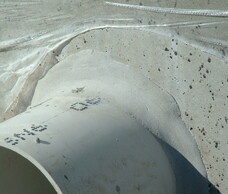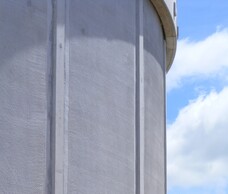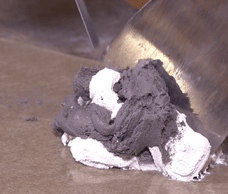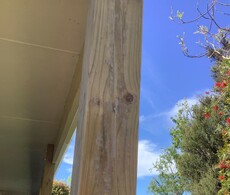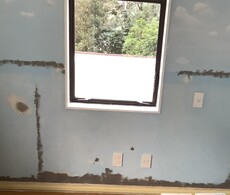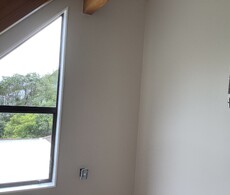Epoxy mortars, pastes and glues
Stratmore manufactures a wide range of epoxies for site, factory, workshop and home/business use. Epoxy mortars, pastes and glues are used to bond and repair concrete, timber, steel, etc for construction, drainage, precast, architectural and other work.
Product
EPAR 705
A two-part, non-slump epoxy mortar formulated to give a strong bond to dry or damp concrete, steel, glass, aluminium etc. EPAR 705 is non-shrink and has excellent chemical resistance. Also available as a 5-minute version which has a 5 minute pot life and 10 minute initial set time.
What's it used for?
The excellent mechanical properties of EPAR 705 combined with ease of use make it an extremely versatile product. Common uses for EPAR 705 include the following:
Bedding and jointing of precast concrete units
Repair of damaged or spalled concrete and protection of reinforcing
Levelling and patching of concrete floors under heavy load or impact
Grouting of starter bars and bolts particularly horizontal or overhead
Fabrication of concrete pipe intersections and general drainage work.
What can it be applied to?
EPAR 705 can be applied to dry or damp concrete, steel, glass, aluminium, timber.
Precautions
For optimal performance with any epoxy system it is important to:
Proportion the hardener and resin accurately.
Thoroughly mix together until of an even colour and consistency.
Use the correct product for the conditions, especially during cold weather.
If potable water contact is required, then refer to EPAR EM Epoxy Mortar.
Not suitable for bonding plastic products.
Product
EPAR EM
A two-part, low-slump and easy-mix epoxy mortar specially formulated to allow hand mixing. Adheres strongly to dry or damp concrete, steel, glass, aluminium, etc. EPAR EM is non-shrink and has excellent chemical resistance. EPAR EM is AS/NZS 4020:2005 compliant for contact with potable water up to 40°C and an immersion exposure level of up to 15,000mm² epoxy per litre of water.
A Fast-Set version is also available. EPAR EM Fast Set has a 15 minute gel time.
What's it used for?
Uses for EPAR EM include:
Assembly and repair of precast concrete units
Repair of spalling concrete and protection of steel reinforcement
Levelling and patching of concrete floors under heavy load or impact
Grouting of starter bars and bolts particularly horizontal or overhead
Fabrication of concrete pipe intersections and general drainage work, including underground work
Applications requiring potable water contact.
EPAR EM Fast Set epoxy system is used where a 15-minute gel time is required and good bond strength is obtained in 1 – 2 hours. Typically, it is used in applications where short curing times are essential.
What can it be applied to?
EPAR EM can be applied to dry or damp concrete, steel, glass, aluminium, timber, etc.
Precautions
For optimal performance with any epoxy system it is important to:
Proportion the hardener and resin accurately.
Thoroughly mix together until of an even colour and consistency.
Use the correct product for the conditions, especially during cold weather.
If potable water contact is required, then allow EPAR EM to fully cure (5 days minimum), then flush down the bonded substrate and discard the water.
Not suitable for bonding plastic products.
EPAR EM Fast Set
15-minute epoxies may creep and are therefore not suitable in applications where they are subject to a high constant load in one direction. In these circumstances, use a standard cure epoxy (EPAR EM).
Product
EPAR EX
A two-part, non-slump epoxy mortar specially formulated to allow hand mixing. Adheres strongly to dry or damp concrete, steel, glass, aluminium, etc. EPAR EX is non-shrink and has excellent chemical resistance.
What's it used for?
Uses for EPAR EX include:
Assembly and repair of precast concrete units
Repair of spalling concrete and protection of steel reinforcements
Levelling of concrete floors exposed to heavy load or impact
Grouting of horizontal or overhead starter bars or bolts
Fabrication of concrete pipe intersections, etc.
What can it be applied to?
EPAR EX can be applied to dry or damp concrete, steel, glass, aluminium, timber.
Limitations
For optimal performance with any epoxy system it is important to:
Proportion the hardener and resin accurately.
Thoroughly mix together until of an even colour and consistency.
Use the correct product for the conditions, especially during cold weather.
If potable water contact is required, then refer to EPAR EM Epoxy Mortar.
Not suitable for bonding plastic products.
Product
EPAR HPN
A soft, two-part thixotropic epoxy mortar/paste, gunable and trowellable. EPAR HPN has excellent adhesion to most materials including concrete, metals, bricks, ceramic, glass etc.
EPAR HPN is non-shrink and has excellent chemical resistance.
What's it used for?
EPAR HPN is used in applications where an epoxy mortar, such as EPAR 705, EM or EX, is not suitable due to viscosity. The excellent mechanical properties of EPAR HPN make it suitable for many applications including the following:
Bedding and jointing of precast concrete units
Grouting of horizontal starter bars and bolts
Repair of spalling concrete and protection of reinforcing
Levelling and patching of concrete floors under heavy load or impact
Fabrication of concrete pipe intersections
Tiling
Bonding of aggregates to concrete etc, for decorative finishes
Bedding of machines and backing plates both vertical and horizontal.
What can it be applied to?
EPAR HPN can be applied to most materials including concrete, metals, bricks, ceramic, glass etc.
Limitations
For optimal performance with any epoxy system it is important to:
Proportion the hardener and resin accurately.
Thoroughly mix together until of an even colour and consistency.
Use the correct product for the conditions, especially during cold weather.
If potable water contact is required, then refer to EPAR EM Epoxy Mortar.
Not suitable for bonding plastic products.
Product
EPAR 802
EPAR 802 is a soft, smooth epoxy paste which is solventless and non-shrink. EPAR 802 can be applied up to 5mm thick on vertical surfaces without slumping and can easily be feathered out or sanded.
EPAR 802 is recommended for applications requiring finer tolerances than are achievable with EPAR epoxy mortars or EPAR HPN epoxy paste.
What's it used for?
The excellent gap filling and adhesive properties of EPAR 802 make it suitable for a wide variety of applications including the following:
Laminating and jointing of fibrous cement sheet
General concrete repair and levelling
Production of exposed aggregate finish by bonding pebbles to a variety of surfaces
Tile adhesive
Smoothing and patching timber, concrete or metal surfaces prior to painting. Can be trowelled to a smooth finish
Filling & smoothing screw holes in fibre cement sheets.
What can it be applied to?
EPAR 802 can be applied to concrete, cement fibre board, timber, tiles, metal, etc.
Limitations
For optimal performance with any epoxy system it is important to:
Proportion the hardener and resin accurately.
Thoroughly mix together until of an even colour and consistency.
Use the correct product for the conditions, especially during cold weather.
If potable water contact is required, then refer to EPAR EM Epoxy Mortar.
Not suitable for bonding plastic products or application to vertical substrates beyond 5mm build thickness.
Product
EPAR GP
EPAR GP is a high strength, two-part epoxy glue. It is non-shrink and suitable for use where gap filling properties are required. EPAR GP, having grease-like viscosity, can be feathered out or applied up to 10mm thick on vertical surfaces. EPAR GP is suitable for service in either dry or wet conditions.
A fast curing (5-minute pot life) version of EPAR GP is also available.
What's it used for?
EPAR GP is suitable for use as a gap filling adhesive or filler for wood, concrete, steel, ceramics etc. Uses include:
Manufacture of timber joinery and furniture. Boat building
Repair and manufacture of formwork for concrete.
Bonding and stopping of fibrous cement sheet
EPAR GP is especially suited as a general woodworking glue for building purposes.
EPAR GP 5 minute is recommended for applications where a very fast setting epoxy adhesive is required - for example, adhering kitchen benches to timber supports.
What can it be applied to?
EPAR GP can be applied to a wide range of substrates including wood, steel, concrete, fibre cement board, etc.
Limitations
Product
FAIRFILL
FAIRFILL is a two-part, light and sandable epoxy fairing and filling compound. FAIRFILL is non-shrinking, nonporous and cold curing thereby allowing application in all temperatures. FAIRFILL is easily sanded using sandpaper, a power sander or other woodworking/finishing tools.
What's it used for?
The excellent finishing properties of FAIRFILL combined with ease of use make it an extremely versatile product for smoothing or filling surfaces before the application of a subsequent coating or paint. FAIRFILL is non-shrink and is easily sanded and finished.
As FAIRFILL is a cold-curing epoxy, curing will take place at temperatures down to 0 °C. There is no need to ensure that the ambient temperature or substrate temperature is above 15°C as is common with most other epoxy products.
What can it be applied to?
Common uses for FAIRFILL are:
Filling screw holes in fibre cement sheet
Boats – smoothing hulls and other surfaces
Repairing formwork
Housing applications (timber poles, weatherboards, wallboards, etc
Model making.
FAIRFILL is particularly suitable for filling gaps and holes in fibre cement sheets.
Limitations
FAIRFILL is not suitable for application to plastic substrates. FAIRFILL should not be used in applications subject to wear as, being sandable, it will be damaged and worn by trafficking.
FAIRFILL may be used as an adhesive in appropriate applications (such as gluing timber back into weatherboards, etc), but a more suitable EPAR epoxy system should be used for more demanding applications.
Information presented on this website must be read in conjunction with the latest technical datasheet, product label and any other application data.
Click here to download technical data

